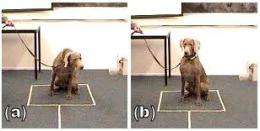How dogs make sense of size

(PhysOrg.com) -- University of Sussex psychologists have demonstrated an ability in domestic dogs to match acoustic and visual cues - a cognitive ability once thought to be found in primates only -when assessing size in other dogs.
Researchers Dr Anna Taylor, Dr David Reby and Karen McComb filmed the reactions of 40 different volunteer pet dogs when presented with two other dogs (a stuffed Jack Russell and a stuffed German shepherd dog) of different size and a variety of manipulated growl recordings.
The playback recordings represented a variety of large and small dogs of different age, breed and sex. Each dog was introduced to the two stuffed models and then heard two "large dog" growls and two "small dog" growls. While each growl was played, the experimenters recorded which stuffed model the dog looked at first, which model the dog looked at longest, and how long the dog looked at each model.
It was found that the amount of attention paid to either the small dog or large dog by each subject was significantly greater when the sound played matched correctly with either model (known as "preferential looking").
The findings are now available in a research paper - Cross Modal Perception of body Size in Domestic Dogs (Canis familiaris) - published in the online open access journal Plos One.
Body size in animals is used to assess potential mates, or the relative strength and dominance of competitors. Animals therefore use visual cues to make decisions on whether to engage in potential social or sexual interaction with other individuals.
In nature many animals have developed the ability to make themselves look bigger than they actually are to ward off enemies or attract mates, meaning that visual clues alone are not entirely reliable indicators of size.
The findings of the Taylor experiment show that domestic dogs have the cognitive ability to match visual cues to size (by looking at the other dog) with acoustic cues to size (by listening to the growling sound made), enabling them to build a more accurate picture of the other animal's status.
The researchers believe that this relatively sophisticated cognitive ability, integrating information on size from different sensory channels, is not restricted to domestic dogs.
Dr Taylor says: "This ability is likely to be crucial to intra-specific interactions between domestic dogs, especially in group situations. The ability to categorically relate information from different sources is particularly relevant to animals when they make social decisions. Future experiments should investigate whether other types of information can be similarly conceptualised."
Dr Reby, from the University's Mammal Vocal Communication and Cognition Research Group in the School of Psychology says: "This study also suggests that the ability to estimate body size from vocal signals, a crucial property of human speech perception, is in fact present across mammalian species. Studying animal vocal communication informs our understanding of the origins of speech production and perception."
More information: Anna M. Taylor, David Reby, & Karen McComb (2011). Cross Modal Perception of Body Size in Domestic Dogs (Canis familiaris) PLoS ONE, 6 (2). www.plosone.org/article/info%3Adoi%2F10.1371%2Fjournal.pone.0017069
Provided by University of Sussex


















